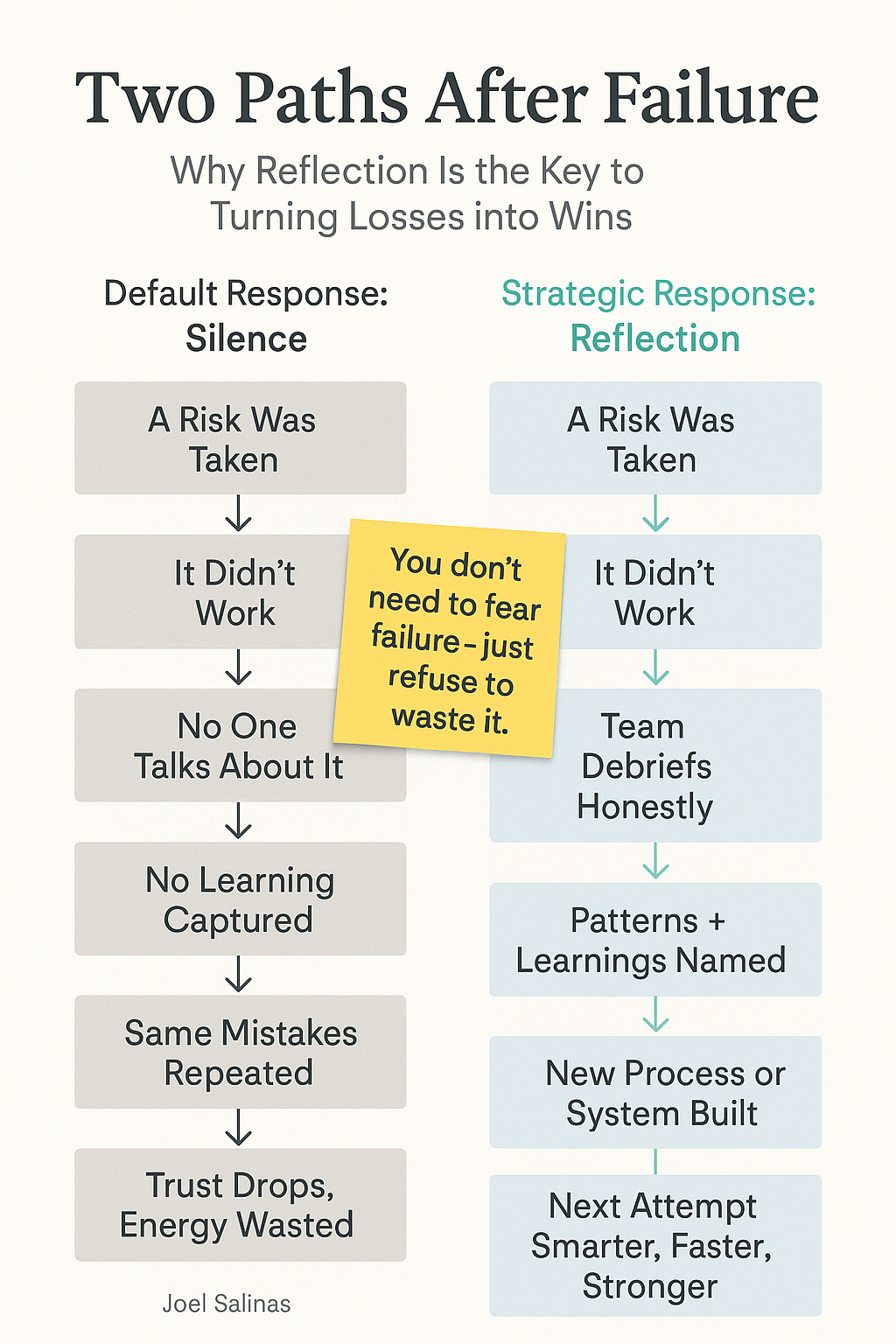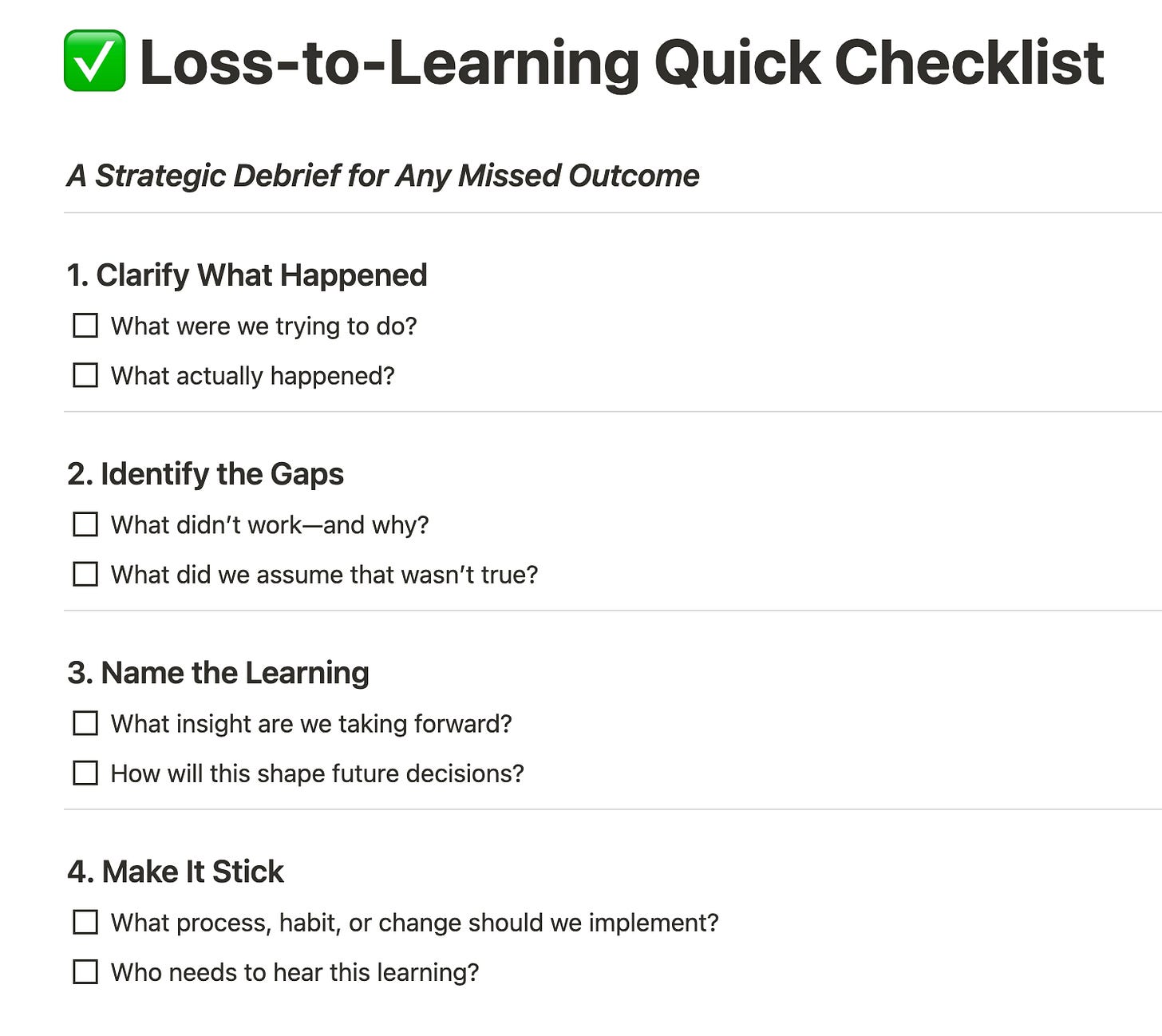3 Ways to Make Sure Every Loss Becomes a Win
& Why Nonprofits Can’t Afford to Waste Failure
Hello! Before we dive in, this is a free publication. If you enjoy it, please support it through a subscription, a restack, or a recommendation.
My Medium friends can read this story there as well.
Most nonprofit and church leaders I know aren’t afraid to take risks. They’re afraid the risks won’t be worth it. When resources are tight and people are counting on you, it’s tempting to play it safe, especially after a failed initiative, a missed grant, or a burned-out team member. But what if there were a way to make every risk worth it?
The truth is, not every effort will succeed. But that doesn’t mean it has to be a loss. This is what I want us all to not just understand but employ. With the right process, even our missteps can become momentum. For mission-driven teams, learning from failure isn’t a luxury. I believe it is a necessity for long-term success.
“The only real mistake is the one from which we learn nothing.” — Henry Ford
Two Very Different Paths After Failure
Before we dive into the how, here’s a simple visual that captures the two most common responses to failure… one that drains trust, and one that builds future strength.
After some honest introspection, what side did your latest failed initiative fall on? We all fail, it’s part of life, part of business, but it is what we do with each failure that determines the likelihood of the next success.
The Sticky Note That Shouldn’t Exist
The now-iconic Post-it Note started as a lab failure. If you don’t know the story, in 1968, 3M scientist Spencer Silver was trying to develop a super-strong adhesive, and FAILED, accidentally making a very weak one. For years, the invention went nowhere. It was a product without a purpose.
But his colleague, Art Fry, saw potential. He took a second look at this apparent failure and looked for a learning opportunity. He used the weak adhesive to anchor bookmarks in his church hymnal. He found something epositionable, non-damaging, and reliable.
What had looked like a misstep became one of 3M’s most profitable product lines. In 2024, it was estimated that the “sticky notes” market had grown to US$ 2,440 million.
What made the difference? The company didn’t bury the failure, they revisited it. They asked better questions. They stayed curious. Even after some time…
That’s not luck.
Why This Matters More in Nonprofits and Churches
In the nonprofit world, our resources may be limited, but our ambitions are not. We’re constantly trying to do more with less: serve more people, deepen impact, and evolve programs. That means we have to innovate, we will try new things, and many don’t work.
But here’s the key: we don’t have the margin to waste those moments.
If a failed pilot program or dropped initiative leads to silence or shutdown, we lose twice: once in the outcome, and again in the opportunity to learn.
I’ve written before that you don’t drift into learning. You build for it. You must set a plan for it, or it will not happen.
Nonprofits need rhythms that make learning from loss not just possible, but predictable. Here’s how…
3 Ways to Make Sure Every Loss Becomes a Win
1. Debrief Everything, Not Just the Bad Stuff
Most teams only debrief when something goes wrong. But if we want learning to be a norm, not a reaction, we need to normalize reflection across the board.
After every launch, campaign, retreat, or meeting series, ask:
What worked?
What didn’t?
What surprised us?
What do we want to repeat, adjust, or drop?
Create simple, repeatable spaces for this. When debriefing is consistent, losses lose their sting, and wins become repeatable.
2. Name the Failure
In healthy cultures, naming what didn’t work isn’t a threat; it’s a gift. It builds trust. It teaches new staff what risk looks like. It makes senior leaders more human.
Make it a norm to say, “Here’s where this didn’t go as planned, and here’s what we’re seeing now because of it.” If leaders don’t model this, teams won’t either. Courageous clarity creates strategic momentum.
3. Turn the Learning Into a Practice
Reflection without action becomes wasted brainpower. Capture the learning in clear ways:
Turn lessons into checklists or “if/then” plans
Document tweaks to processes or communications
Use losses to inform new strategies
The goal is not just knowing better, it’s building a system that makes doing better easier the next time.
Practical Application: My Failure Debrief Checklist
When something doesn’t go as planned, whether it’s a campaign, event, hire, or decision, the real opportunity isn’t in fixing it. It’s in learning from it. But most teams skip this step or simply take it as sunk cost and move to the next initiative with the hope for a better outcome.
That’s where this simple tool comes in.
Use this Loss-to-Learning Checklist as a go-to resource whenever things go sideways. You can do this in under 15 minutes—solo or with your staff.
And when paired with the “Two Paths After Failure” visual, you now have both:
A mindset map (what happens if you don’t reflect), and
A process guide (exactly how to reflect well)
Together, they form a strategic rhythm for learning, not just surviving mistakes but getting stronger through them.
TL;DR – If You Only Remember This:
You don’t need to fear failure, just refuse to waste it
Debriefing consistently turns both wins and losses into momentum
Naming failure builds trust, not shame
The goal is not just insight, but new habits
Nonprofits can’t afford to play it safe, but they also don’t have to play it blind
On the topic of learning, here are a few great authors I have been learning from through their clear, practical newsletters:
Brian Clark for entrepreneurship and business insights.
AI CFO Office for the intersection of AI strategy and corporate leadership.
Ryan Burge for the intersection of politics and religion, a topic that should resonate with us more now than anytime in the past decade.
John Pavlovitz for honest reflections on the biggest societal issues in the US today.
If this reframed how you think about failure, reflection, or momentum, I’d love for you to subscribe and share. I write to support leaders navigating change with clarity, courage, and strategic hope. Let’s keep learning.





Great post, love the sticky note anecdote!